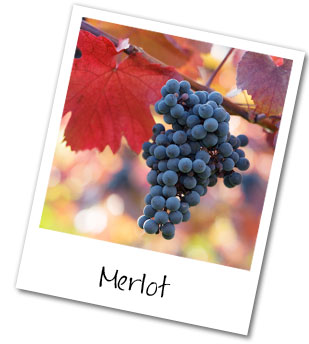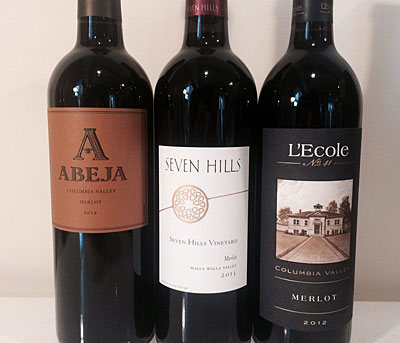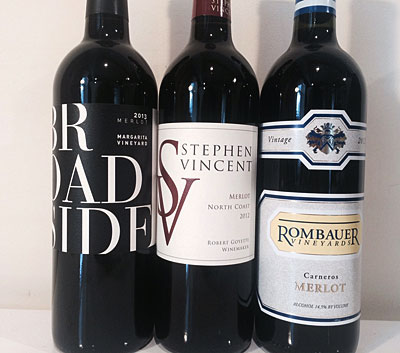| « Previous | News | Next » |
October 28, 2015
Highs and Mer-lots - Great Wine Transcends Fashion
Jack: “If they want to drink Merlot, we’re drinking Merlot.”
Miles: “No, if anyone orders Merlot, I’m leaving. I am NOT drinking any f&!king Merlot!”
(Sideways, 2004)
We need to talk about Merlot. Voluptuous, sexy, friendly, extroverted—there’s a lot to like about this grape. And during the nineties, like it people did. It rose in popularity so fast and so furiously that “Merlot” became synonymous with “red wine” in the U.S., even outpacing sales of Cabernet Sauvignon. Many credit its rise to a 1991 60 Minutes episode called the “French Paradox” that suggested red wine was good for fighting heart disease. According to the Washington Post, “During the ensuing four weeks, red wine sales in U.S. supermarkets surged 44 percent (or 2.6 million bottles)….Merlot is the grape that boomed. It was easy for newcomers to pronounce and easier to drink as a cocktail than the leading red alternative, Cabernet Sauvignon, as it tends to be a little less acidic and astringent….The wine industry got behind the grape in a big way, and in California alone, acreage planted with Merlot increased from 8,000 acres in 1992 to 33,000 by the end of 1996.” (02/2005) By the mid-nineties, Merlot was indeed having a moment.
Voluptuous, sexy, friendly, extroverted—there’s a lot to like about this grape. And during the nineties, like it people did. It rose in popularity so fast and so furiously that “Merlot” became synonymous with “red wine” in the U.S., even outpacing sales of Cabernet Sauvignon. Many credit its rise to a 1991 60 Minutes episode called the “French Paradox” that suggested red wine was good for fighting heart disease. According to the Washington Post, “During the ensuing four weeks, red wine sales in U.S. supermarkets surged 44 percent (or 2.6 million bottles)….Merlot is the grape that boomed. It was easy for newcomers to pronounce and easier to drink as a cocktail than the leading red alternative, Cabernet Sauvignon, as it tends to be a little less acidic and astringent….The wine industry got behind the grape in a big way, and in California alone, acreage planted with Merlot increased from 8,000 acres in 1992 to 33,000 by the end of 1996.” (02/2005) By the mid-nineties, Merlot was indeed having a moment.
But, as so often happens with instant fame, Merlot’s reputation was soon on the road to ruin. Hyper demand led to overplanting, overirrigating, overfertilizing, and overpicking from immature vineyards. Like many a celebrity, the grape is fickle: it likes its soil cool, but too cool and it displays green, herbaceous characteristics; it needs sun, but too much and it loses its acid and structure. Many of the wines being produced during the boom were lackluster at best. As with all bubbles, Merlot Madness was soon showing signs of bursting.
Enter Sideways. By the time this 2004 movie made its infamous denouncement of the grape, consumers were ready to abandon ship—sales plummeted while Pinot, which the film waxed rhapsodic about, saw sales rise. According to the Napa Valley Register: “Prior to the initial release of “Sideways” on Dec. 18, 2004, Merlot was up to a 15 percent market share while Pinot Noir still held steady at 2 percent. After “Sideways,” things changed…Merlot sales had dropped to 12 percent while Pinot Noir sales had increased to 5 percent of overall wine sales.” (01/2012)
Poor Merlot! Yes it had made mistakes. But it was the victim of money-hungry producers who didn’t know how to handle its stardom. (Sonoma winery Gundlach Bundschu created a genius video about the rise and fall of this much misunderstood grape in America: https://youtu.be/6efO9ReiKQM) When given the right conditions, think of the great heights it can reach: it can display layers of dried, concentrated fruits plus chocolate, tobacco, and floral notes with a va-va-voom body, and, if lucky, the verve to back it up. Clay soils in Bordeaux’s Right-Bank St-Emilion and Pomerol regions are perfect for this grape: the clay stays cool and retains moisture, which crucially delays bud break for the early-ripening Merlot. There’s good reason that Merlot-dominant Chateau Petrus is one of the most lauded—and expensive—wines in the world. In fact, in Sideways, Miles’s most prized bottle of wine is ironically a 1961 Ch. Cheval Blanc, which is a blend of Merlot and Cabernet Franc, another varietal that he disparaged. So maybe instead of bemoaning the past, we think of this as a clearing of the slate. Bad Merlot has been, for the most part, kicked to the curb, leaving room for some truly interesting juice. In both Washington and California (Oregon is too cool), you can find Merlot that hits all the right notes: that time-honored Merlot hedonism, with a dash of street smarts. This is a grape that has seen highs and lows, and is now all the better for it.
Washington State
From L’Ecole on Washington State’s uniquely Merlot-friendly growing conditions: “For Merlot to strut its stuff it needs long, warm, sunny days to ripen matched with cool nights so as to retain its natural acidity and beautiful balance. Sitting at 46° latitude, Washington receives more than 17 hours of sunshine each day during the peak growing season and sees up to a 40° diurnal temperature swing once the sun goes down. It’s no secret that eastern Washington can be a windy place. That wind exposure stresses the vines and encourages them to grow thicker skins, resulting in more robust tannins and improved cellaring potential. Normally thin skinned, Merlot tends to plump up when exposed to water during the final ripening stages. Fortunately, we rarely see rainfall during harvest in Washington, and I believe this is a key reason we can make such extracted, aromatic, and beautifully balanced Merlots.”
L’Ecole No. 41 2012 Merlot, Columbia Valley
L’Ecole No. 41 is an institution in Walla Walla. It was the third winery to open in the region (1983), and only the 20th in the state. They have won the prestigious Winery of the Year in Wine and Spirits magazine a whopping 13 consecutive times. The 2012 has bright and buoyant acidity, which balances its deep concentration. It opens with notes of juicy plum, dried cherry, blueberry, mocha, caramel, and hints of violets. On the palate, it shows tobacco leaf and licorice. With a nice medium weight and long finish, this is a great steak wine.
Abeja 2012 Merlot, Columbia Valley
Deeply invested in Washington State viticulture, this small team of four adventurers creates rich, structured wines with sustainable practices (certified LIVE and Salmon Safe). Their wines are made from a combination of estate fruit and sourced from like-minded growers. The 2012 Merlot is dark garnet in the glass, with aromas of blackberry pie, vanilla, mocha, and iron. This is full-throttle palate-coating, and would be gangbusters with a blue-cheeseburger.
Seven Hills 2013 Merlot, Seven Hills Vineyard, Walla Walla Valley
Founder and winemaker Casey Mclellan has been making Seven Hills wine in Walla Walla since 1988, and this long history with his sites has put him on intimate terms with his fruit: “I have been fortunate in my many years as Seven Hills winemaker to have developed fruit sources where I harvest from the same rows-the same vines each year. This is a precious resource for us, knowing the vines and working closely with our growers, we can craft wines attaining the full potential of the grape.” The 2013 Merlot is a fiery blood red color, with attractive blood, cherry, earth, graphite, and pepper notes. There’s a light touch of vanilla and baking spice to this medium-bodied wine. The tannins are firm and grippy, with a nice acidity making it a good table companion. This is a tomato sauce Merlot, so grab a plate of lasagna.
California
California Merlot is what started the domestic craze. From Jancis Robinson: “American Merlot’s crucial characteristic is not its flavour but its texture which can be, and frequently is, described in one word - smooth. This is a wine to caress the palate, a wine that inspired that great new word in American wine jargon, ‘mouthfeel.’ What enabled this of course was the Californian climate. There was no argument, as in Bordeaux, about whether Merlot grapes would ripen fully. The grapes would, in the best examples, be picked as late as possible to achieve full, ‘physiological’ ripeness, picked not according analyses of their sugar and acid content but by whether the grapes had started to shrivel and their stalks to turn brown and woody.” (Wine Grapes)
Rombauer 2012 Merlot, Carneros
Opened in 1980, this family operation has great vineyard sources and cutting-edge technology. They use optical fruit scanners to separate absolutely perfect fruit from everything else. They use aerial infrared technology to map the vineyard canopies. Nothing but the highest quality fruit goes into their wines. The 2012 Merlot is plush and full, with distinctive savory notes of pepper, balanced by sweet blueberry and licorice on a velvety, but ultimately structured palate. Pair with lamb meatballs or mushroom risotto.
Stephen Vincent 2012 Merlot, Central Coast
Winemaker Robert Goyette brings five decades of experience to the table. After founding La Crema and working at Benzinger, his Stephen Vincent wines are geared toward exceptional quality at affordable prices. The 2012 hits the mark: full-bodied and busty, showing dried bing cherry, with a perfumey violet candy quality. There’s brown sugar and creme brulee sweetness on the palate. Acid is the key here, and draws everything together in harmony. Try beef stew.
Broadside 2013 Merlot, Margarita Vineyard, Paso Robles
Brian and Stephanie Terrizzi have a natural, minimalistic approach to winemaking. They harvest at lower sugars, use native yeasts, and little to no new oak. These are table wines, to be sure. The 2013 is exciting. It has the weight of a Cru Beaujolais and really shows Merlot in a more delicate form. On the nose, it expresses roses, pepper, cedar, and violets. It’s lovely and bright on the palate with notes of cranberry and raspberry. Vibrant and well done. Smoked salmon would pair well.


